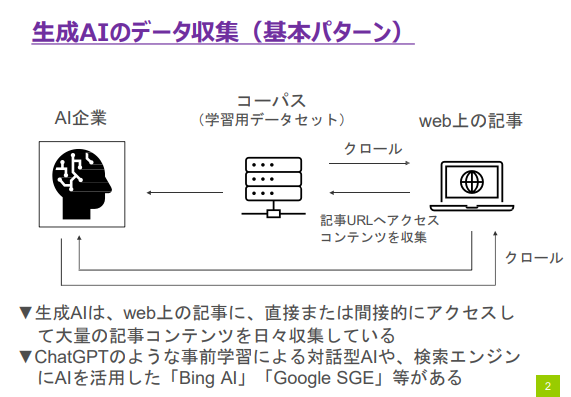目次
12月号【法務】ニュースレター
メタバース上のコンテンツ等をめぐる新たな法的課題
当所ニュースレターでは、過去2か月にわたって、意匠審査基準ワーキンググループにおいて検討されている「新規性喪失の例外適⽤⼿続の緩和」について、詳細にお知らせしてきた。2023年9⽉29⽇に開催された第23回意匠審査基準ワーキンググループでは、参考資料として「メタバース上のコンテンツ等をめぐる新たな法的課題等に関する論点の整理 」が配布されたようだ。
当ニュースレターでは、上記配布資料の中から、「メタバース上のコンテンツ等の権利保護」について、意匠権を中心として検討された論点を紹介する。
背景
(以下「メタバース上のコンテンツ等をめぐる新たな法的課題等に関する論点の整理 」から)
近年、メタバースにおいてアバターが使用する「実用品」をユーザーが販売したり、メタバース内に仮想店舗を開き、リアル・バーチャル両方において商品を販売する現実世界の企業等が出現している。現実の製品デザインが仮想空間で利用され、仮想空間のデザインが現実の製品に転用されるなど、現実と仮想空間との間を交錯して同一/類似のデザインが利用されている。
このような状況下において、現実の意匠権者の保護、および仮想空間における創作の保護について、論点の整理が必要となった。
論点・課題
(2-1) 現実商品のデザイン模倣
メタバースでは、例えば、実在する製品の特徴的なデザインを模倣した仮想アイテムが販売されるなど、現実の製品デザインが無断で使用される事案が生じている。このような場合、当該デザインに係る意匠権が及ぶ範囲について、また権利保護の在り方について、検討していくべきである。
(2-2)リアルとバーチャル双方でのビジネス展開
同一のデザインに基づいて、リアルとバーチャル双方の実用品を販売する等のビジネスモデルも登場している。これらの商品のデザインが、どのように保護されるのかが課題となる。
制度・取扱い等の現状
(3-1) 意匠権による保護
(3-1-1) 物品等の意匠としての保護
① 登録意匠に係る「物品」又は「建築物」の製造・建築、使用、譲渡等の行為を、権利者に無断で行えば、意匠権侵害となる。しかし、物品と仮想オブジェクト(3Dデータ)とでは機能・用途が異なり、登録意匠を仮想空間内で実施しても、登録意匠の実施と判断されない可能性が高い。このため、仮想オブジェクトが無断で実施されたとしても、意匠権侵害は成立しないと判断される可能性が高いことが想定される。
(3-1-2) 画像意匠としての保護
① 意匠法が保護対象とする画像は、①機器の操作の用に供されるもの(操作画像)、および②機器がその機能を発揮した結果として表示されるもの(表示画像)のみである。そのため、アバターの使用する仮想アイテム等である画像(コンテンツ)は、意匠を構成しないものとされる。
② 意匠権による保護は、依拠性の有無にかかわらず類似の意匠に及ぶため、保護対象をコンテンツにまで広げた場合、クリエイターの創作活動に萎縮効果を生じさせる等の懸念が指摘される。
③ 仮想アイテム等については、オリジナルデザインであっても「画像意匠」として保護対象とならない。したがって、仮想アイテム等については、仮想空間でのデザイン模倣に対抗するため、物品等と画像両方について意匠登録を受けるといった方法も、取り得ないこととなる。
(3-2) 著作権による保護
① 実用品のデザイン(応用美術)は、著作物性が認められにくいため、現実の実用品のデザインが著作物性を否定された場合、当該デザインが仮想空間で利用されることとなっても、著作権の保護対象とはならない。
② 仮想世界の実用品である仮想アイテム等は、応用美術に当たらないとして、著作物性を肯定される場合があることが想定される。
(3-3) 不正競争防止法による保護
① 不正競争防止法による商品形態模倣規制による保護では、保護対象が有体物である必要がある。このため、他人のデザインをデッドコピーした仮想オブジェクトを作成・販売等したとしても、当該規制は及ばないものとされる可能性が高い。
対応の方向性
① 不正競争防止法
ネットワーク上の形態模倣商品提供行為も規制対象とし、「商品」に無体物を含むとするなど、ネットワーク上の商品形態模倣品の提供行為を規制できるようにしていくことが適当である。
② 意匠法による対応
クリエイターの創作活動に対する萎縮効果を生じさせる等の懸念があるため、中長期的な課題として慎重に検討することが適当である。
③継続的な把握・検討
著作権による保護がどこまで及び得るかについては、応用美術の著作物性等に関する裁判例の傾向や、実務の積み重ねを踏まえ、まずは考え方を整理した上で適切に周知を図っていくことが望ましい。
日本新聞協会「AI時代の知的財産権検討会」で著作権法改正要望
2023年11月2日、一般社団法人日本新聞協会は、内閣府が実施する意見募集に対応して、AI時代における知的財産権に関する意見を提出した。
著作権法の2018年改正で、著作権者の許諾がなくても著作物をAIの学習に利用できるとする「第30条の4」の規定が設けられた。同条ただし書きで「著作権者の利益を不当に害する」場合は利用できないと留保は付けられているものの、「不当に害する行為」の範囲は明確ではなく、現在の著作権法では、報道各社が作成、著作権等の法的権利を有する報道コンテンツについて、生成AIの学習過程で利用されており、AIの開発者やサービス提供者が、対価なくタダ乗り(フリーライド)している。
このような状況に鑑み、日本新聞協会は日本政府(内閣府知的財産戦略推進事務局)に対して、以下の意見を述べた。
<意見>(筆者要約)
政府は、著作権者の権利保護の観点から、著作権法の改正を含め、生成AI技術の急速な進化に見合った適切なルール整備を急ぐべきである。
具体的には、著作権法「第30条の4」を見直し、少なくとも、AIによる「学習」を著作権者が拒否できる、もしくは、利用時には許諾を得る仕組みの整備が必要である。また、ただし書き「不当に害する行為」の範囲を明確にすべきである。
<理由>(筆者要約)
報道コンテンツは、新聞・通信各社が多大な労力と様々なコストをかけて作成した貴重な知的財産である。一般消費者が対話型AIや検索エンジンにAIを活用した「Bing AI」「Google SGE」等の検索結果や回答で満足し、オリジナルサイトにアクセスしないとなると、報道機関はコスト回収の機会を著しく奪われる。
生成AIによるデータの無断使用により報道機関の収益機会が損なわれ、良質なニュースコンテンツを提供し続けることが困難になれば、国民の「知る権利」が阻害される。
また生成AIによる報道コンテンツの無断使用が疑われる事例だけでなく、報道コンテンツをもとに、事実関係に誤りのある回答が生成された事例、記事盗用の疑いがある海賊版サイトをもとに回答が作成された事例なども確認されている.
ニュースコンテンツが国民に適切に提供されず、虚偽の情報が拡散、偽情報を学習したAIが、さらに偽情報を拡散するとなると、民主主義の基盤が揺らぎ、選挙などに悪影響を及ぼす危険性さえある。
さらには、報道各社は有償で記事データベースを提供している場合もあるが、一方で、最近では、AI開発にも使える情報解析用の記事データ集(コーパス)も販売されている。
生成AIによる報道コンテンツのデータ収集(データ蓄積)は、新聞社が手掛ける記事データ販売市場と衝突しており、著作権法「第30条の4」のただし書き「著作権者の利益を不当に害する場合」に該当する可能性がある。

参考URL:https://www.kantei.go.jp/jp/singi/titeki2/ai_kentoukai/gijisidai/dai3/siryou2.pdf
[参照]
https://www.pressnet.or.jp/statement/20231106_1.pdf
農林水産省、米国農務省との植物品種保護に係る「日米審査協力覚書」へ署名
2023年10月27日、農林水産省と米国農務省との間で、植物品種の保護に係る「日米審査協力覚書」が締結された。これにより、日本から米国への出願品種の審査に当たり、米国は、日本の品種登録審査結果を用いることが可能となった。
日本で育成された優良品種は、海外の輸出市場でも高い評価を受けている。このような評価を維持するためには、日本で育成された優良な品種が海外流出し、無断で増殖されることがないように対策を講じる必要がある。輸出時の水際対策も重要であるが、植物品種の外国における侵害に対処するためには、当該国において品種登録が行うことが特に重要である。
海外品種登録は、審査のために種苗の提出を求められることがあり、種苗の輸出はもちろん、輸出後も審査に適した状態まで生育させる必要があるなど、手続き面および費用面で、国内品種登録出願と比較してハードルが高いものとなっている。
そんな中、日本では、海外における品種登録を促進するため、植物の新品種の保護に関する国際条約(UPOV(※)条約)の枠組の下、加盟国が、相手国からの出願品種の審査を行う際は、その相手国における審査結果を活用する「審査協力」を進めており、円滑な審査・迅速な登録を推進している。
※ UPOV(ユポフ):INTERNATIONAL UNION FOR THE PROTECTION OF NEW VARIETIES OF PLANTS
今回締結された「日米審査協力覚書」により覚書締約国は全部で16カ国となった。今後、米国における審査期間の短縮による日本優良品種の保護の迅速化が期待される。
現在、覚書を締結している国・地域は以下。

参考URL:https://www.maff.go.jp/j/press/yusyutu_kokusai/syubyo/attach/pdf/231027-1.pdf
[参照]
https://www.maff.go.jp/j/press/yusyutu_kokusai/syubyo/231027.html
Newsletter translated into English

New Legal Challenges Concerning Content, etc. in the Metaverse
For the past two months, we have reported in our newsletters in detail on the “Relaxation of Application of Exceptions to Lack of Novelty” which is under consideration by the Working Group on Design Examination Criteria. At the 23rd meeting of the Working Group on Design Examination Criteria held on September 29, 2023, “Categorization of Issues Concerning New Legal Challenges Regarding Contents, etc. in the Metaverse” was distributed as a reference material.
In this newsletter, we would like to introduce some of the issues discussed in the above reference material, with a focus on design rights, regarding the “protection of rights for content, etc. in the metaverse”.
Background
(from the “Categorization of Issues Concerning New Legal Challenges Regarding Contents, etc. in the Metaverse”)
In recent years, companies in the real world have emerged that sell “practical items” used by avatars in the metaverse, or that open virtual stores in the metaverse and sell products both in the real and virtual worlds. Same/similar designs are used across the real world and the virtual space, as for example real-world product designs are used in the virtual space, and designs in the virtual space are used for real-world products.
Under these circumstances, it was necessary to clarify the issues regarding the protection of design owners in reality and the protection of creations in virtual space.
Issues and discussion points
(2-1) Design imitation of real products
In the metaverse, there have been cases of unauthorized use of real product designs. For example, virtual items that imitate the distinctive design of a real product are sold. In such cases, the scope of design rights pertaining to such designs and how the rights should be protected needs to be examined.
(2-2) Business development in both real and virtual worlds
Business models such as selling both real and virtual products based on the same design have emerged. The issue is how the design of these products will be protected.
Current status of systems, handling, etc.
(3-1) Protection through design right
(3-1-1) Protection as a design of an article, etc.
(1) The manufacture, construction, use, transfer, etc. of an “article” or “building” pertaining to a registered design without the right holder’s permission constitutes an infringement of the design right. However, the functions and uses of an article and a virtual object (3D data) are different, and even if a registered design is implemented in a virtual space, it is highly likely that it will not be judged an implementation of the registered design. Therefore, it is assumed that even if a virtual object is implemented without permission, it is highly likely that design infringement will not be deemed to have occurred.
(3-1-2) Protection as an image design
(1) The Design Law protects only (a) those images that are used to operate the device (operation images) and (b) those that are displayed as a result of the device performing its function (display images). Therefore, images (contents) that are virtual items, etc. used by avatars do not constitute a design.
(2) Since protection through design extends to similar designs irrespective of dependency, there are concerns that widening the scope of protection to contents may have an atrophying effect on creators’ creative activities.
(3) Virtual items, etc. are not subject to protection as “image designs” even if they are original designs. Therefore, regarding virtual items, etc. it is not possible to register design for both the article, etc. and the image of as a method to counter design imitations in the virtual space.
(3-2) Protection by copyright
(1) With regard to designs for practical products (applied art), if copyrightability is denied for the design of a practical product in the real world as copyrightability is unlikely to be recognized for such products, the design is not subject to copyright protection even if it is used in a virtual space.
(2) It is assumed that there may be cases in which virtual items, etc., which are practical articles in the virtual world, are affirmed as copyrightable because they do not fall under the category of applied art.
(3-3) Protection under the Unfair Competition Prevention Law
(1) Protection under the Unfair Competition Prevention Law’s regulation on product form imitation requires that the object to be protected is a tangible object. Therefore, even if a virtual object that is a dead copy of another person’s design is created, sold, etc., it is highly likely that the said regulation will not apply.
Direction of Response
(i) Unfair Competition Prevention Law
It is appropriate to make the act of providing product form imitations on a network subject to regulation, and to make the act of providing product form imitations on a network regulable, for example, by including inanimate objects in “products”.
(2) Measures under the Design Law
It is appropriate to carefully consider this issue as a medium- to long-term issue, as there are concerns that it may have an atrophying effect on creators’ creative activities.
(3) Continuous monitoring and examination
It is desirable to first organize the concept of how far the protection by copyright can extend, based on the trend of court precedents on the copyrightability of applied arts and the accumulation of practical experience, and then make it known to the public in an appropriate manner.
Request for Revision of the Copyright Law at the Japan Newspaper Publishers Association’s “Study Group on Intellectual Property Rights in the AI Era”
On November 2, 2023, the Japan Newspaper Publishers & Editors Association submitted its opinion on intellectual property rights in the age of AI in response to a request for opinions issued by the Cabinet Office.
The 2018 revision of the Copyright Act established a provision in “Article 30-4”, which states that copyrighted works can be used for AI learning without the permission of the copyright holder. Although the proviso of the same article states that the use cannot be made if it “unreasonably harms the interests of the copyright holder”, the scope of “unreasonably harming acts” is not clear. Under the current Copyright Law, news content created by news companies and for which they have legal rights such as copyright can be used in the learning process of the generative AI, and AI developers and service providers are getting a free ride (free ride) without compensation.
In light of this situation, the Japan Newspaper Publishers & Editors Association expressed the following opinions to the Japanese government (Intellectual Property Strategy Headquarters, Cabinet Office).
<Opinion> (summarized by the author)
From the viewpoint of protecting the rights of copyright holders, the government should hasten the development of appropriate rules commensurate with the rapid evolution of generative AI technology, including the revision of the Copyright Act.
Specifically, “Article 30-4” of the Copyright Law should be revised to at least allow copyright holders to refuse “learning” by AI, or to establish a mechanism to obtain permission when using AI. In addition, the scope of the proviso “unreasonably harmful acts” should be clarified.
<Reasons> (Author’s summary)
News contents are valuable intellectual property created by newspapers and telecommunications companies at great effort and at various costs. If the general public is satisfied with search results and answers provided by interactive AIs and search engines such as “Bing AI” and “Google SGE” that utilize AIs, and do not access the original sites, news organizations will be severely deprived of opportunities to recover their costs.
Unauthorized use of data generated by AI will undermine profit-making opportunities for news organizations, and if it becomes difficult for them to continue providing quality news content, the public’s “right to know” will be hampered.
In addition to cases of suspected unauthorized use of news contents by generative AI, there have also been confirmed cases where answers with erroneous facts were generated based on news contents, and where answers were generated based on pirate websites suspected of plagiarizing articles.
If news content is not properly provided to the public, false information spreads, and AI that has learned from false information further spreads false information, the foundation of democracy will be shaken, and there is even a risk of adverse effects on elections, etc.
Furthermore, news companies may provide article databases for a fee. On the other hand, recently, collections of article data (corpus) for information analysis, which can also be used for AI development, has been sold.
Data collection (data accumulation) of news contents by generated AI clashes with the article data sales market handled by newspaper companies, and may fall under the proviso of “Article 30-4″ of the Copyright Law”, i.e. “unreasonably harms the interests of the copyright holder”.

Reference: https://www.kantei.go.jp/jp/singi/titeki2/ai_kentoukai/gijisidai/dai3/siryou2.pdf
[Reference]
https://www.pressnet.or.jp/statement/20231106_1.pdf
MAFF Signs “Japan-U.S. Memorandum of Understanding for Cooperation in Plant Variety Protection Examinations” with U.S. Department of Agriculture (USDA)
On October 27, 2023, a “Japan-U.S. Memorandum of Understanding for Cooperation in Examination” was signed between the Ministry of Agriculture, Forestry and Fisheries (MAFF) and the U.S. Department of Agriculture (USDA) regarding the protection of plant varieties. This allows the U.S. to use the results of Japanese variety registration examinations when examining varieties applied for in the U.S. from Japan.
Superior varieties bred in Japan are highly regarded in overseas export markets. In order to maintain this reputation, it is necessary to take measures to prevent superior varieties bred in Japan from leaking overseas and being propagated without permission. While control measures at the time of export are important, it is particularly important that variety registration be carried out in foreign countries in order to deal with infringement of the variety in those countries.
Overseas variety registration is a more difficult hurdle than domestic variety registration in terms of procedures and costs, as the applicant may be required to submit seeds and seedlings for examination, and the seeds and seedlings must be grown to a suitable condition for examination after export.
Under the framework of the International Convention for the Protection of New Varieties of Plants (UPOV Convention), Japan is promoting “examination cooperation,” in which member countries use the examination results of the variety applied for in other countries for the purpose of facilitating the smooth examination and prompt registration of varieties overseas.
The “Japan-U.S. Memorandum of Understanding for Cooperation in Examination” concluded on this occasion brings the total number of countries that are parties to the MOU to 16. It is expected that the MOU will speed up the protection of Japanese superior varieties by shortening the examination period in the U.S.
The countries and regions that have concluded the MOU are as follows:

Reference: https://www.maff.go.jp/j/press/yusyutu_kokusai/syubyo/attach/pdf/231027-1.pdf
[Reference]
https://www.maff.go.jp/j/press/yusyutu_kokusai/syubyo/231027.html
